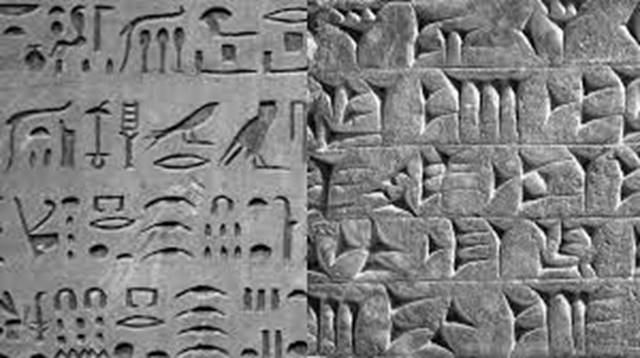

Timeless Myths
The Linguistic Legacy of Ancient Civilizations: From Hieroglyphs to Cuneiform
The ancient civilizations of the world left behind a rich linguistic legacy that continues to fascinate and intrigue us today. From the intricate hieroglyphs of ancient Egypt to the complex cuneiform script of Mesopotamia, these ancient writing systems provide valuable insights into the lives, cultures, and beliefs of our ancestors. In this blog post, we will explore the origins, characteristics, and significance of hieroglyphs and cuneiform, shedding light on the linguistic marvels of ancient civilizations.
Hieroglyphs: The Enigmatic Script of Ancient Egypt
Ancient Egypt is renowned for its majestic pyramids, pharaohs, and mummies. However, one of the most enduring legacies of this civilization lies in its hieroglyphic script. Hieroglyphs, which literally means "sacred carvings," were a system of writing used by the ancient Egyptians from around 3200 BCE until the 4th century CE.
Hieroglyphs were a combination of pictograms, ideograms, and phonetic symbols. They were primarily inscribed on stone monuments, temples, and tombs, serving both practical and ritualistic purposes. The decipherment of hieroglyphs was a monumental achievement, achieved primarily by the French scholar Jean-François Champollion in 1822. His work unlocked a treasure trove of historical and cultural information encoded in the hieroglyphic inscriptions.
The hieroglyphic script allowed the ancient Egyptians to record their religious beliefs, myths, historical events, and daily life. It provided a means of communication between the living and the dead, as hieroglyphs were often found in burial sites and sarcophagi. Each hieroglyph represented a word or a sound, and the script was read from right to left or left to right, depending on the direction of the hieroglyphs.
Cuneiform: The Script of Mesopotamia
While the ancient Egyptians were perfecting hieroglyphs, another great civilization was developing its own writing system in Mesopotamia. Cuneiform, which means "wedge-shaped," was the script used by the Sumerians, Babylonians, and Assyrians from around 3200 BCE until the 1st century CE. It is considered one of the earliest known writing systems in the world.
Cuneiform was written on clay tablets using a stylus made of reed. The script consisted of wedge-shaped marks made by pressing the stylus into the clay. Initially, cuneiform was used for accounting and administrative purposes, but it soon evolved into a complex writing system capable of expressing a wide range of ideas and concepts.
Unlike hieroglyphs, cuneiform was a syllabic script, meaning that each symbol represented a syllable. It included around 600 signs, which could be combined to form words or represent specific words or concepts. The decipherment of cuneiform was a challenging task that required the collaboration of several scholars over many years. Notable among them was the British archaeologist Sir Henry Rawlinson, who successfully deciphered the Persian cuneiform inscriptions in 1835.
Similarities and Differences: Hieroglyphs vs. Cuneiform
Hieroglyphs and cuneiform were both highly sophisticated writing systems that played crucial roles in the cultural, religious, and administrative spheres of their respective civilizations. However, they differed in several aspects.
One notable difference is the medium on which they were inscribed. Hieroglyphs were primarily carved on stone or painted on walls, whereas cuneiform was impressed on clay tablets. This distinction reflects the different environments and materials available to the ancient Egyptians and Mesopotamians.
Another difference lies in their visual appearance. Hieroglyphs consisted of intricate pictorial symbols, often representing objects or ideas directly. In contrast, cuneiform symbols were abstract and wedge-shaped, representing sounds or syllables rather than images. This distinction makes hieroglyphs more visually appealing and cuneiform more abstract and utilitarian.
Despite these differences, hieroglyphs and cuneiform shared some similarities. Both scripts were logographic, meaning that some symbols represented entire words or concepts. Additionally, both systems required extensive knowledge and training to master, as they were not easily accessible to the common people.
Significance and Legacy
The linguistic legacy of ancient civilizations is not merely an academic curiosity; it provides invaluable insights into the development of human communication and the evolution of writing. Hieroglyphs and cuneiform represent significant milestones in the history of writing, demonstrating the ingenuity and intellectual capabilities of our ancestors.
The decipherment of hieroglyphs and cuneiform unlocked a wealth of knowledge about ancient civilizations, allowing us to understand their religious beliefs, political systems, historical events, and everyday life. These scripts provided a means for the transmission of culture and knowledge across generations, bridging the gap between the past and the present.
Furthermore, the decipherment of these ancient writing systems laid the foundation for the study of linguistics and philology. It sparked an interest in ancient languages and scripts, inspiring generations of scholars to unravel the mysteries of other forgotten scripts and languages.
In conclusion, the hieroglyphs of ancient Egypt and the cuneiform script of Mesopotamia are remarkable linguistic legacies that continue to captivate us today. These ancient writing systems provide windows into the past, enabling us to glimpse the lives, beliefs, and achievements of our ancestors. The decipherment of hieroglyphs and cuneiform represents a triumph of human intellect and curiosity, reminding us of the enduring power of language and the importance of preserving our linguistic heritage. - Words Trivia

